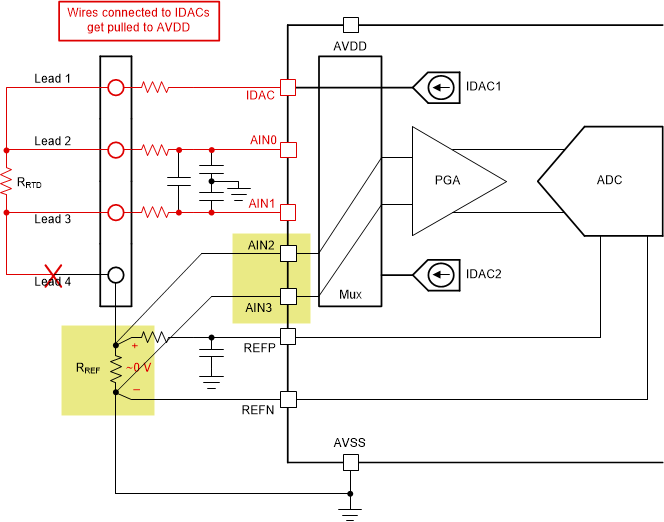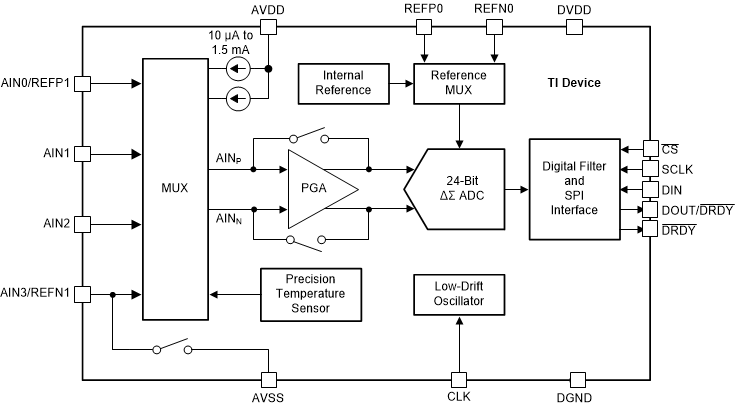SBAA483 February 2021 ADS1120 , ADS112C04 , ADS112U04 , ADS114S06 , ADS114S06B , ADS114S08 , ADS114S08B , ADS1220 , ADS122C04 , ADS122U04 , ADS124S06 , ADS124S08 , ADS125H02 , ADS1260 , ADS1261 , ADS1262 , ADS1263
- Abstract
- Trademarks
- 1Introduction
- 2Features Used to Detect Wire Breaks in RTD Systems
- 3Wire-Break Detection Methods for Different RTD Configurations
- 4Settling Time Considerations for RTD Wire-Break Detection
- 5Summary
- A How Integrated PGA Rail Detection Helps Identify Wire Breaks
- B Pseudo-Code for RTD Wire-Break Detection
2.3 Detecting a Wire Break Using Separate Analog Inputs
If the ADC does not have any method for integrated VREF monitoring, Figure 2-3 shows how a dedicated set of analog inputs can be used to measure back the reference voltage using the ADC signal path.
 Figure 2-3 Detecting a Wire Break Using
Separate Analog Inputs
Figure 2-3 Detecting a Wire Break Using
Separate Analog InputsThe system in Figure 2-3 uses AIN0 and AIN1 to measure the RTD voltage and AIN2 and AIN3 are used to read back the voltage across RREF. Just like in the periodic VREF monitoring case, a fault is detected if the measured voltage between AIN2 and AIN3 is close to 0 V. At this point, the host can take corrective action if necessary. Similar to the case described in Section 2.2, the challenge with this approach is that the VREF voltage cannot be monitored constantly. Instead, RTD measurements must be halted in order to switch over to the monitoring channel, increasing system latency and complexity compared to using an ADC with an integrated VREF monitor. Moreover, the ADC requires another reference voltage source when using separate analog inputs to measure back the VREF voltage, as the reference voltage source for the RTD is now the measurement channel.
Although increased latency resulting from internal multiplexer switching cannot be overcome, the system can be simplified as shown in Figure 2-3 by using an ADC with multifunction analog inputs. Using such an ADC eliminates the dedicated traces running from RREF to the input multiplexer because REFx are shared with AINx. As an example, Figure 2-4 illustrates how REFP1 and REFN1 are shared with AIN0 and AIN3, respectively, in the ADS1220.
 Figure 2-4 ADS1220 Block Diagram
Figure 2-4 ADS1220 Block DiagramTable 2-2 summarizes the wire-break detection features integrated into the precision ΔΣ ADCs highlighted in Table 1-1.
| Device | Dual, Matched IDACs? | VREF Monitor? |
|---|---|---|
| ADS1120 | Yes: any analog input | Periodic = (VREFPx – VREFNx) / 4 |
| ADS112C04 | ||
| ADS112U04 | ||
| ADS1220 | ||
| ADS122C04 | ||
| ADS122U04 | ||
| ADS114S06B | Continuous = 300-mV threshold | |
| ADS114S08B | ||
| ADS114S06 | ||
| ADS114S08 | ||
| ADS124S06 | ||
| ADS124S08 | ||
| ADS1260 | Continuous = 400-mV threshold | |
| ADS1261 | ||
| ADS1262 | ||
| ADS1263 | ||
| ADS125H02 | Yes: dedicated pins |
For the remainder of this document, the continuous VREF monitor is used to detect RTD wire breaks because this method is the simplest to implement. However, using a periodic VREF monitor or dedicated analog inputs are still acceptable methods for determining wire breaks in all configurations.